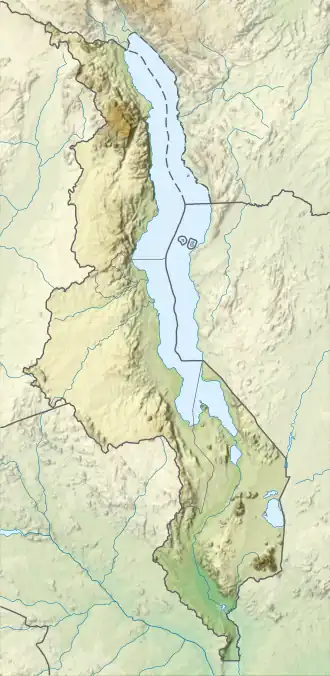Mwabvi Wildlife Reserve
| Mwabvi Wildlife Reserve | |
|---|---|
IUCN category IV (habitat/species management area) | |
 | |
| Location | Nsanje District, Malawi |
| Coordinates | 16°40′S 35°0′E / 16.667°S 35.000°E |
| Area | 135 km2 |
| Established | 1953 extended 1975 |
| Governing body | Department of National Parks and Wildlife |
Mwabvi Wildlife Reserve is the smallest wildlife reserve in Malawi, covering approximately 135 km² (52 mi²) in the Nsanje District near the southernmost tip of the country.[1] It includes a portion of the Matundwe Range, which forms a part of the border with Mozambique, and is situated near the Shire River lowlands. The park's elevation is between 150 m (492 ft) and 400 m (1,312 ft) above sea level.[2] It is located near Lengwe National Park and Majete Wildlife Reserve.
Mwabvi Wildlife Reserve features a wide variety of habitats including mopane, combretum, dry brachystegia woodland, open savanna, dambo, sandstone hills, and riverine areas.
Project African Wilderness, a nonprofit organization, was formed to protect and restore Mwabvi Wildlife Reserve.[3][4] In February 2007, the organization signed a management agreement with Malawi's Department of National Parks and Wildlife to take over the conservation and development of the park.[5]
Wildlife
Mwabvi Wildlife Reserve has historically supported a larger faunal diversity than it does today. In the mid-20th century, it was the last stronghold of Malawi’s black rhinoceros population.[6] The reserve was once home to all of Africa’s “Big Five” game animals, but decades of heavy poaching dramatically reduced its populations of megafauna.[7] By the late 20th century, black rhinos, elephants, and lions were extirpated from the reserve. Today, the only remaining population of Africa's "Big Five" game animals is the Cape buffalo.[8] Poaching remains a serious threat to Mwabvi's wildlife.
Several antelope species and other small to mid-sized mammals are commonly found in the reserve. These include small herds of nyala, sable antelope, greater kudu, impala, suni, and common duiker.[9] Warthogs, baboons, and vervet monkeys are also present.
Larger predators are observed infrequently in the reserve. Leopards, spotted hyenas, jackals, and servals have been recorded, but only in very low numbers.[10] There are no resident lion prides, although lions residing primarily in neighboring Mozambique have been seen in the reserve.[1][2]
Mwabvi has a diverse bird population, with over 270 bird species documented in the reserve.[11] Notable birds include the Woodward’s batis, and grey waxbill, among hundreds of other species adapted to the dry woodland and savanna habitat.[12] Birdwatching is a source of tourism in the reserve.[13]
References
- ^ a b Travel, Malawi. "Mwabvi Wildlife Reserve". Malawi Travel. Retrieved 2025-08-01.
- ^ a b "Flora of Zimbabwe: Location details: Mwabvi Wildlife Reserve". www.zimbabweflora.co.zw. Retrieved 2025-07-24.
- ^ Macdonald, Lindsey (2011-12-11). "Gaynor Asquith obituary". The Guardian. ISSN 0261-3077. Retrieved 2025-06-30.
- ^ "THE PROJECT AFRICAN WILDERNESS TRUST - Charity 1108662". prd-ds-register-of-charities.charitycommission.gov.uk. Retrieved 2025-07-22.
- ^ Briggs, Philip; Connolly, Sean (2013). Malawi. Bradt Travel Guides. p. 236. ISBN 978-1-84162-474-7.
- ^ "MWABVI WILDLIFE RESERVE". Shire Valley. Retrieved 2025-08-09.
- ^ "MWABVI WILDLIFE RESERVE". Shire Valley. Retrieved 2025-08-09.
- ^ "MWABVI WILDLIFE RESERVE". Shire Valley. Retrieved 2025-08-09.
- ^ "Mwabvi Wildlife Reserve – Visit Malawi". Retrieved 2025-08-09.
- ^ "MWABVI WILDLIFE RESERVE". Shire Valley. Retrieved 2025-08-09.
- ^ "Mwabvi Wildlife Reserve – Visit Malawi". Retrieved 2025-08-12.
- ^ "Mwabvi Wildlife Reserve – Visit Malawi". Retrieved 2025-08-09.
- ^ "Luxury Safari | African Safari Magazine". African Safari. Retrieved 2025-08-09.